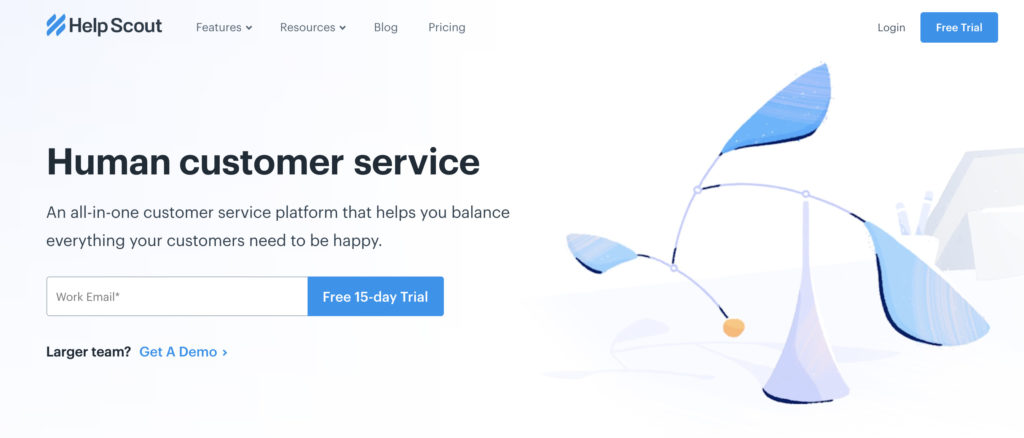Last updated: April 20, 2021
‘The following blog post is an edited down conversation between the co-founder and CEO of Outfunnel, Andrus Purde, and Tim Thyne, Head of Sales & Account Management at Help Scout. (You’ll find the link to the recording at the end of the post.)

Help Scout is a customer service platform that is used by 12,000+ small businesses to better serve their customers. It serves as a platform to manage live chat, email support, and self-service help documentation and resources.
How does Help Scout get new customers?
Tim: Historically, we like to think of Help Scout as a self-service driven business. Although we do have a sales channel, we also have folks on support who are proactively working with customers who are considering Help Scout.
The history of the business has always been inbound. Everything starts from our content. We’ve built a wealth of really good content for customer service professionals – not only for the leaders of customer service teams, but also for the front line folks who are doing the work in the day-to-day.
When we started the company in 2011, we didn’t have a sales team. Everything was purely self-service driven. People came to our website, they read our content, they opted in for a trial, and then they converted to a paying customer. It wasn’t until the later half of 2015 and early 2016 or that we actually formally introduced a sales role. When we introduced sales, we did not introduce it to drive growth from an outbound standpoint. It was to better serve inbound requests that were coming in.
Help Scout started by focusing on a self-service model with inbound content for customer service professionals. They more recently (~2016) introduced a sales role focused on helping to guide larger customers.
So over time as our traffic continued to grow, trials signups and demo requests grew. We realized that larger customers needed a little bit more help. They liked somebody to help guide them through not only what was possible with the software, but really give advice on how they can figure out what custom setups they need. They wanted help with the change management – training the team migrating their data, things of that nature.
So we really introduced the sales role to help work with those larger customers in our inbound funnel. We are now starting to experiment with what outbound could look like, and we’re seeing some really good early success.
How does Help Scout’s sales team direct its attention towards signups? What is the qualification process?
Tim: First, we look at our high-intent inbound funnel. These are folks who are interested in evaluating the product – and our two most popular inbound channels are our trials sign-ups and demo requests.
One of the qualifying questions we always ask is how many users do you expect to use Help Scout. We don’t just ask because it tells us how much money you would pay us, although that is one factor – but the other reason is that teams of different sizes often have very different requirements for how they purchase and get started with our software.
The main qualifying question is “how many users do you expect to use Help Scout”.
If you plan to have 11 or fewer users, you end up entering into what we call our support-driven growth funnel. This is primarily a self-service funnel, though we do we augment that with some personal interaction.
If you go through the sales funnel if you’re with 11 or more planned users, you have a dedicated contact person. We’ll schedule time with you, walk you through the entire evaluation process, everything from the demos to the account setup to training and onboarding.
If are in the bucket that’s under 11 users – ideally the product is good enough to get you through the process on your own, but we do have a team of folks that will reach out to proactively based on specific triggers.
How did introducing a dedicated sales function affect conversion rates from trial to paid?
Tim: So the 1-to-10 funnel and the 11+ funnel both performed significantly better when we’ve added some level of touch. Not only do they convert at much higher percentages – the other thing that we’ve seen happen is folks that engage with us churn at an incredibly low rate. And they grow exponentially more than the folks that come in a purely self-service way.
So we need to make sure that when we engage with customers, we help them really understand all that’s possible with Help Scout.
How does Help Scout think about KPIs? Are they separate or shared across the three functions?
Tim: On the sales channel specifically, there’s a whole bunch of metrics we can track to understand progress along the way. But there are a couple of core metrics. One is: what are the total opportunities driven into the sales funnel. An opportunity for us is an inbound request that has showed intent to evaluate.
Sales doesn’t work with folks who just subscribe to our blog or download an ebook. They’re only working with folks who have intent to evaluate the product. So we look at what are the total opportunities generated. That’s a KPI that marketing is responsible for.
Help Scout focuses on looking at “sales-engaged opportunities” – inbound requests that have shown intent to evaluate.
But then the next one is a shared KPI and that’s what we call our “sales-engaged opportunity”. And that is once we’ve established a two-way dialogue, and have verified intent with the opportunity.
So both marketing and sales have “sales-engaged opportunities” as a KPI. And that’s because although sales is responsible for all of the outreach, marketing is equally as responsible for making sure that those opportunities that come in have a strong intent to evaluate.
Do shared KPIs ever create any tension between the teams?
Tim: I could be biased, but I don’t think there’s any finger-pointing when it comes to the shared KPIs. For us, we’re all on the same journey to drive up that sales-engaged number. We are looking at it constantly. What changes are we seeing?
If we see numbers going up and to the right, that’s great. If we see it dipping down, that’s not so great, but I would say we approach it the same way. We ask why. Why is this number going up now? Is it something that sales is doing differently? Is it something marketing has done differently? If it’s going down, what’s changed?
We always approach it from a collaboration standpoint and we’re always trying to get it to go up but I think that “why” is the key thing that helps us keep progressing, as a team, together. We’re just trying to learn together. Therefore everyone’s mindset is always “why, why, why.” If we messed something up, great, let’s learn from it.
The teams are focused on learning together, understanding why numbers are going up or down in relation to whatever changes were made.
Here’s an example. Marketing recently changed some CTAs on the website to be a bit more self-service focused and away from the demo request, which is a big driver for us. And we saw a dip, so we asked what’s happening here? Sales didn’t get upset with marketing about that, we’re just happy that we learned from it.
Apart from common KPIs, what else does Help Scout do differently to keep sales, marketing and support aligned?
Tim: We constantly remind ourselves that, at the end of the day, we want to hit our numbers but it’s not just about a team succeeding. It’s really about the customer. The revenue that we’re driving is an output of customer success.
So that’s something we have to be mindful of. We’re not optimizing for team performance here, we’re optimizing for customer experience and that’s something that helps all three of our teams stay aligned does that that should be the North Star. Anytime there’s a problem or there’s friction in the funnel, we should focus on what’s gonna be the best experience for the customer, not what we want to optimize for on a spreadsheet.
What indicators does Help Scout use to measure customer success?
Tim: From a tracking standpoint I’d say our North Stars are growth and retention. Customers are successful if they’re continuing to grow with us, and they’re not churning.
Each team also looks at product adoption. We’ve found that some core features particularly help drive user success. So we just ensure that as customers move along their journey with us, they’re adopting the features we believe will be most helpful for them based on whatever goal they’re trying to accomplish.
Even long-time customers can overlook core features, and have to be reminded of them.
Tim: Just last week we talked to a customer who’s been with us since 2012. And it turns out they didn’t know about a core feature in the product that’s been there the whole time, that’s adopted by a majority of our customer base.. Although we have classes, webinars, and emails that go out about this feature, it was not something that was top-of-mind for them. And they were blown away by functionality that’s been there for the last seven years.
So reminding your customers of the value of the features in context of how they use your tool is really important. It’s easy to just assume everybody knows what’s possible. And that’s often not the case.
What tools does Help Scout use to support its sales, marketing, and support-driven growth?
Tim: There are a couple of core tools, and then a bunch of other tools that support everything. So we have…
– Help Scout – we use Help Scout for all of our customer service. It’s also what the support-driven growth track uses for all of their proactive outreach to customers.
We have Salesforce as our CRM.
And then we have HubSpot that we use for all of our marketing automation, our email campaigns.
So Help Scout, HubSpot, Salesforce are the three primary systems of record and then there are other tools in our sales tech stack.
We use Troops for setting up a bunch of alerts that come from Salesforce and to keep everybody up to date. We use Mix Max for all of our templates our sequencing our calendar invites. It plugs right into Gmail and also integrates with Salesforce. We use Chorus alongside Zoom for all of our sales recordings. That way we have them to reference back and share with customers, and also for training purposes.
Closing thoughts
Tim: What I’ve seen with customers is that every team has to make sacrifices. If every team is using a product, there are sacrifices on the sales side, on the marketing side, and then also on the services side. I think the best path for a lot of customers, especially small businesses, is to buy products that do exactly what they want incredibly well, and then make sure the different tools are tightly integrated.
Don’t buy tools that optimize for you as the business, buy tools that optimize for your customers.
Tim Thyne, Help Scout
I think Help Scout often plays incredibly well for small businesses with a lot of the other CRMs that specialize in small businesses and integrates with the marketing tools for small businesses. So I’d say, keep an eye on Help Scout, and as you have customer service needs, make sure whatever system you buy, is going to deliver your customers a personal experience. Don’t buy tools that optimize for you as the business, buy tools that optimize for your customers, and then also solve for your business needs.
Further reading to learn more about Help Scout
- What Is Support-Driven Growth? – how support has become a revenue generator for the business how they’ve implemented the process
- Sales as a Service – talks about how Help Scout has built the sales seem to be a little bit more service-oriented than strictly like a transactional sales process




